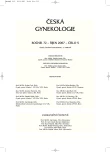-
Medical journals
- Career
Da Vinci Robotic Surgery in Gynaecological Oncology: a Critical Interim Appraisal
Authors: P. Bartoš 1; D. Struppl 2; M. Trhlík 1; S. Czudek 3; M. Škrovina 3; L. Adamčík 3; R. Soumarová 4
Authors‘ workplace: Gynekologicko-porodnické oddělení, Onkologické centrum J. G. Mendela, Nový Jičín vedoucí pracoviště prim. MUDr. P. Bartoš, Ph. D, M. MED 1; Gynekologické oddělení Nemocnice Na Homolce, Praha 2; Chirurgické oddělení, Onkologické centrum J. G. Mendela, Nový Jičín 3; Radioterapie, a. s., Onkologické centrum J. G. Mendela, Nový Jičín 6
Published in: Ceska Gynekol 2007; 72(5): 354-359
Category: Original Article
Overview
Objective:
Benefit evaluation of robot-assisted surgery in gynecological oncology. The parameters observed were feasibility, safety, overal surgery length and economic aspects.Design:
Prospective study analysing our experience in 10 patients operated due to gynaecological malignancy, adnexal tumors or planned for the procedure used as a part of extensive oncological surgery.Settings:
Department of Gynecology and Minimally Invasive Surgery Na Homolce Hospital, Prague.Methods:
The surgeries were performed with Da Vinci robotic system (Intuitive Surgical, inc., USA) including surgeon’s console with stereoscopic viewer with hand and foot controls. The second component of the system was In Site vision system with 3D 12 mm endoscope. The third part comprised of 3 telerobotic arms with Endowrist instruments. From 2/2006 to 9/2006 10 patients were operated upon. 2 patients with early invasive cervical cancer, 2 patients with cervical cancer in situ (CIS), 3 patients with complex ovarian tumors, 2 patients with symptomatic atypical endometrial glandular hyperplasia and 1 patient underwent necessary gynecological surgery as a part of oncological treatment of breast cancer. The range of surgery included Total robotic hysterectomy, Robot-assisted vaginal hysterectomy with adnexectomy and frozen section, Robot-assisted radical vaginal trachelectomy with pelvic lymphadenectomy and unilateral adnexectomy with frozen section. The average age of patients was 52 years (range 32 – 58 years). 30% of patients had a previous laparotomy in their history.Results:
All procedures were finished with robot-assisted system. In 2 patients a temporary conversion to laparoscopy was made. In 3 patients a technical fault of the robotic system was noticed. This was corrected during the surgery. The overal surgery time was significantly longer (29 hours for robotassisted versus 12 hours for laparoscopy). This represented operation time increase of 59 % in comparison to identical laparoscopic procedures in our department in 2006. This was caused by lengthy assembly and disassembly time of the robotic system. No patients experienced any peroperative or postoperative comlications. The costs in our setting were approximately 10times higher in comparison to laparoscopy.Conclusion:
Our preliminary experience shows that Robot-assisted surgery is comparable to the standard laparoscopic procedure in terms of feasibility and outcome, but costs are considerably higher owing to longer operating time and the use of more expensive instruments. A major limitation is the lack of a large operation field. The enormous costs and the lack of appropriate instruments can be a major problem in the further expansion of robotic surgery. The use of robotic system in gynecologic oncologic surgery and in abdominal surgery in general offers, at this stage, no relevant benefit and thus is not justified. Clinical data demonstrating improved outcomes are so far lacking for robotic surgical application within the abdomen.Key words:
Da Vinci robotic surgery, oncology, laparoscopy
Labels
Paediatric gynaecology Gynaecology and obstetrics Reproduction medicine
Article was published inCzech Gynaecology

2007 Issue 5-
All articles in this issue
- Inherited Metabolic Disorders and Pregnancy
- Sperm Banking before Gonadotoxic Treatment – 11-years Experience
- Lycopene Therapy in Male Infertility
- Socioeconomic Datas, the Course of Pregnancy and Delivery in Opioid-addicted Women and Women under Substitution Therapy
- Prediction of Preeclampsia Using the Integrated Test Markers
- Determination Concentrations of Tissue Factor Pathway Inhibitor and their Changes during Estrogen Replacement Therapy
- Progression and Regression Low Grade Intraepitelial Squamous Lesions in Context of Positivity of High Risk Human Papillomavirus
- Basal-like Carcinoma of the Breast – the Actual Review and Clinico-Pathological Corelations
- Da Vinci Robotic Surgery in Gynaecological Oncology: a Critical Interim Appraisal
- Current Condition of Diagnosis and Therapy of Overactive Urinary Bladder in Czech Republic
- Czech Gynaecology
- Journal archive
- Current issue
- Online only
- About the journal
Most read in this issue- Inherited Metabolic Disorders and Pregnancy
- Basal-like Carcinoma of the Breast – the Actual Review and Clinico-Pathological Corelations
- Da Vinci Robotic Surgery in Gynaecological Oncology: a Critical Interim Appraisal
- Progression and Regression Low Grade Intraepitelial Squamous Lesions in Context of Positivity of High Risk Human Papillomavirus
Login#ADS_BOTTOM_SCRIPTS#Forgotten passwordEnter the email address that you registered with. We will send you instructions on how to set a new password.
- Career

